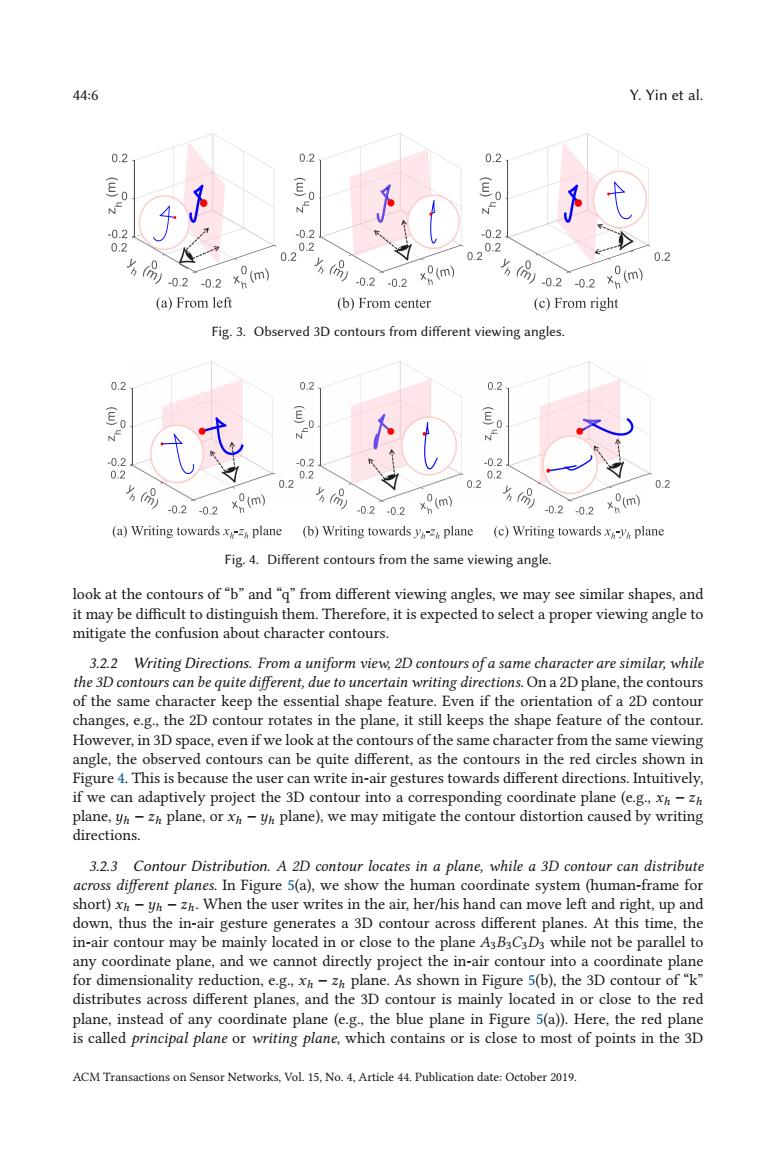正在加载图片...

44:6 Y.Yin et al. 0.2 02 0.2 E (w) 0 N -0.2 -0.2 0.2 0.2 0.2 0.2 0.2 0.2 0 0.2 )0202 x(m) 0.2-02 (m) 0202 x(m) (a)From left (b)From center (c)From right Fig.3.Observed 3D contours from different viewing angles. 0.2 0.2 0.2 -0.2 0.2 0.2 0.2 0.2 0.2 0.2 02 0.2 0.2-0.2 x(m) -02-02 (m) 片份0202 x(m) (a)Writing towardsx plane (b)Writing towards y plane (c)Writing towards x plane Fig.4.Different contours from the same viewing angle. look at the contours of"b"and "q"from different viewing angles,we may see similar shapes,and it may be difficult to distinguish them.Therefore,it is expected to select a proper viewing angle to mitigate the confusion about character contours. 3.2.2 Writing Directions.From a uniform view,2D contours of a same character are similar,while the 3D contours can be quite different,due to uncertain writing directions.On a 2D plane,the contours of the same character keep the essential shape feature.Even if the orientation of a 2D contour changes,e.g.,the 2D contour rotates in the plane,it still keeps the shape feature of the contour. However,in 3D space,even if we look at the contours of the same character from the same viewing angle,the observed contours can be quite different,as the contours in the red circles shown in Figure 4.This is because the user can write in-air gestures towards different directions.Intuitively, if we can adaptively project the 3D contour into a corresponding coordinate plane(e.g.,xh-zh plane,yh-zh plane,or xh-yh plane),we may mitigate the contour distortion caused by writing directions. 3.2.3 Contour Distribution.A 2D contour locates in a plane,while a 3D contour can distribute across different planes.In Figure 5(a),we show the human coordinate system(human-frame for short)xh-yh-zh.When the user writes in the air,her/his hand can move left and right,up and down,thus the in-air gesture generates a 3D contour across different planes.At this time,the in-air contour may be mainly located in or close to the plane A3B3C3D3 while not be parallel to any coordinate plane,and we cannot directly project the in-air contour into a coordinate plane for dimensionality reduction,e.g.xh-zh plane.As shown in Figure 5(b),the 3D contour of"k" distributes across different planes,and the 3D contour is mainly located in or close to the red plane,instead of any coordinate plane (e.g.,the blue plane in Figure 5(a)).Here,the red plane is called principal plane or writing plane,which contains or is close to most of points in the 3D ACM Transactions on Sensor Networks,Vol 15.No.4.Article 44.Publication date:October 2019.44:6 Y. Yin et al. Fig. 3. Observed 3D contours from different viewing angles. Fig. 4. Different contours from the same viewing angle. look at the contours of “b” and “q” from different viewing angles, we may see similar shapes, and it may be difficult to distinguish them. Therefore, it is expected to select a proper viewing angle to mitigate the confusion about character contours. 3.2.2 Writing Directions. From a uniform view, 2D contours of a same character are similar, while the 3D contours can be quite different, due to uncertain writing directions. On a 2D plane, the contours of the same character keep the essential shape feature. Even if the orientation of a 2D contour changes, e.g., the 2D contour rotates in the plane, it still keeps the shape feature of the contour. However, in 3D space, even if we look at the contours of the same character from the same viewing angle, the observed contours can be quite different, as the contours in the red circles shown in Figure 4. This is because the user can write in-air gestures towards different directions. Intuitively, if we can adaptively project the 3D contour into a corresponding coordinate plane (e.g., xh − zh plane, yh − zh plane, or xh − yh plane), we may mitigate the contour distortion caused by writing directions. 3.2.3 Contour Distribution. A 2D contour locates in a plane, while a 3D contour can distribute across different planes. In Figure 5(a), we show the human coordinate system (human-frame for short) xh − yh − zh. When the user writes in the air, her/his hand can move left and right, up and down, thus the in-air gesture generates a 3D contour across different planes. At this time, the in-air contour may be mainly located in or close to the plane A3B3C3D3 while not be parallel to any coordinate plane, and we cannot directly project the in-air contour into a coordinate plane for dimensionality reduction, e.g., xh − zh plane. As shown in Figure 5(b), the 3D contour of “k” distributes across different planes, and the 3D contour is mainly located in or close to the red plane, instead of any coordinate plane (e.g., the blue plane in Figure 5(a)). Here, the red plane is called principal plane or writing plane, which contains or is close to most of points in the 3D ACM Transactions on Sensor Networks, Vol. 15, No. 4, Article 44. Publication date: October 2019